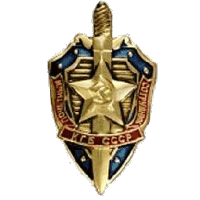






Shemya's Opposition
The main thrust of all of the intelligence missions located on the "Rock" were the Soviet activities on and around the Kamchatka Peninsula. The most important activities were the tests conducted by the Soviet Strategic Rocket Forces, but the Soviet Pacific Fleet operations were almost as important.
There was limited activity by the normal Soviet Army units, they were essentially a massive reserve for the Border Patrol.
The Soviet Air Force was limited to an air defense mission.
The organization of the Soviet military had only limited resemblance to the American/European model.
Below the Red Star are the Collar Insignia for the major forces over the water from Shemya: the Air Forces [VVS], the Radio-Technical Forces [RTV], the Naval Fleets [VMF], and Naval Aviation [VMF-VS].
Below those is the badge of the Committee of State Security [KGB].
The Soviet Air Forces, in general, fly only over land and the coastal waters of the USSR. The Radio-Technical Forces provide communications for Soviet forces. The Naval Fleets are responsible for areas outside the coastal waters. The KGB are integrated into just about everything.
Under the Soviet system maps were classified documents. The only people with access to accurate maps were members of the KGB and high party officials. All Soviet era navigators were members of the KGB, whether they worked for the military, the merchant marine, the airlines, the fishing fleet, etc.
The Soviet trawlers that sat off Shemya probably had some fishermen on board, but the bulk of the crew belonged to the Radio-Technical Forces and the KGB. The Soviet Fleets acknowledged some of the trawlers and manned them with Naval crews, in addition to the RTV and KGB forces.
The long-range reconnaissance aircraft that made passes around Alaska were part of Soviet Naval Aviation. The TU-95s and TU-16s used for these missions are based on the Kamchatka Peninsula.
The activities of Soviet submarines were a major concern of American intelligence. The deep trench south of Shemya was a natural highway between Kamchatka and the West Coast of the United States. The thermal bands in the trench act as shields against sonar detection.
In spite of the lack of population, the Aleutian Islands and Kamchatka Peninsula were a "target rich" environment for the military forces of both the U.S. and USSR.